Papo & Yo Message Board

Quicos best friend, Monster, is a huge beast with razor-sharp teeth, but that doesnt scare Quico away from playing with him. As Quico, players will build their friendship with Monster by solving puzzles together and adventuring through a magical, surrealist world. Players will need to learn to use Monsters emotions, both good and bad, to their advantage if they want to complete their search for a cure and save their pal.
*Offer ends April 28th at 10AM Pacific Time


Just as I wrote about graffiti in Papo & Yo back in July, I wanted to share another story and video diary about how we captured the unique music and sound to transport players deeper into the South American favela of Quico’s imagination. And with the flood of requests we’ve gotten since launch, I’m excited to announce that the Papo & Yo soundtrack will be available for purchase starting tomorrow on PSN in North America! As a special release day promotion, it will be on sale for 15% off the regular price (30% off for Plus members) until January 4th.
Over the past few months, some of you may have caught my tweets about our brilliant composer and sound designer, Brian D’Oliveira from La Hacienda Creative. Fun facts like “Brian D’Oliveira learned about 15 new instruments to play for Papo & Yo!” or “when Monster runs, the sound effect actually comes from hitting a fridge,” are just a glimpse of the music’s backstory in Papo & Yo.
Many people won’t realize that the soundtrack of Papo & Yo is actually dynamic and interactive, triggered by actions such as Quico moving, standing still, and pulling levers, and Monster getting angry. In some levels, there are up to 30-40 layers of music and 60-70 layers of sound effects, all blended together. When Quico pulls the first lever to build the stacking snake ladder in the puzzle we call “Bend Them to Your Will” (seen in the picture below), players trigger the drums and the music builds as each house is added on.

Bend them to your will, Papo & Yo
As you saw in the video diary above, the majority of the sounds in Papo & Yo are as authentic as can be, since Brian actually traveled to the Amazonian rainforest to record ambient noise in the field. Venturing out in the middle of the night, he was able to capture wildlife sounds like monkeys howling, frogs croaking, and birds chirping. Hiking through the land, Brian recorded waterfalls, scurrying ants, and whatever else he thought he could use, layering it into an immersive soundscape players can get lost in.
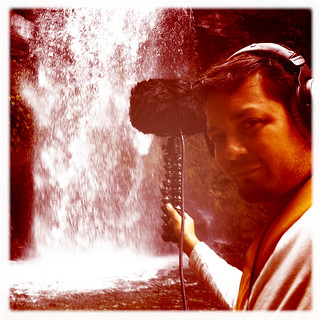
Brian D’Oliveira, capturing ambiance
For Foley (the sound effects track in the game), Brian and his team at La Hacienda had to think “outside of the box” to avoid using pre-mixed sounds that wouldn’t do the story justice. They had exploratory sessions where they would just improvise and see what sounds could be made, or captured on the fly, like recording the noise of a demolition site down the street. Driven by a deep love for the project, Brian and his team went the distance, importing roof shingles from Texas, buying rare instruments, and even building makeshift instruments to create the right sounds. Here is a great example in the video below.
For the music in Papo & Yo, Brian used a fusion of rhythm, melodies, and sounds from South American countries like Brazil, Colombia, and Venezuela, but also drew influences from India, Africa, and even early European Baroque music. It’s really evident in the variety of instruments he used –- from a rare, 100-year-old Sarangi, to an African Kora and Brazilian hunting whistles, all paired alongside traditional instruments like guitars, flutes, violin, and cello.
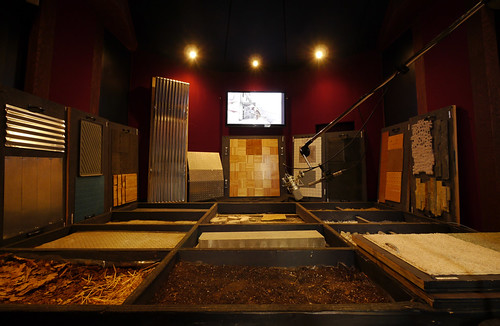
Preparation for recording Foley
Brian plays approximately 80% of the instruments you hear in the game, but he also collaborated with great musicians like Orlando ‘VoVo’ Conceinçao on percussion (pictured below), Loga Ramin Torkian on Bowed Guitar Viol & Kamaan, Kamal Sabri on Lead Sarangi and Elinor Frey on Baroque Cello.
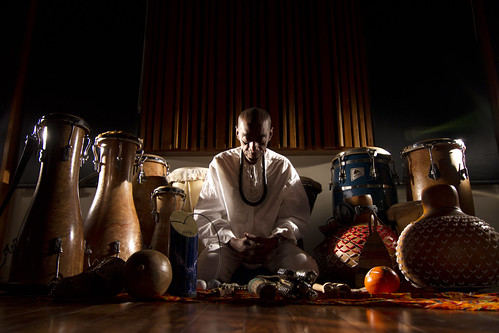
Orlando ‘VoVo’ Conceinçao on percussion
All of the music in Papo & Yo was recorded live, track by track, because Brian “wanted the music to be honest and fragile, with all of the beautiful imperfections that come with live playing.” With a troubled childhood and an absentee father of his own, Brian says he identified with the story of Papo & Yo, and it pushed him to grow both personally and musically as the game developed. In his words: “I feel like I composed the soundtrack to my life.”
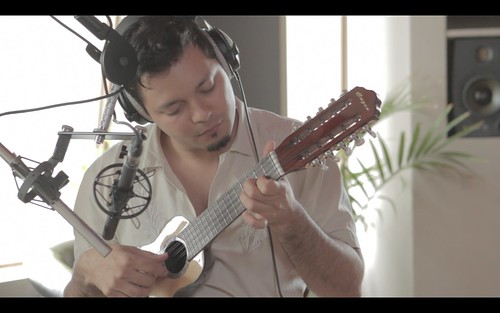
Brian playing an African kora
If you have questions for Brian or Minority, please write them in the comments below or Tweet them to @we_are_minority and @La_Hacienda, and we’ll be glad to answer them. Don’t forget that the soundtrack goes on sale tomorrow — get yours ASAP! If you haven’t had a chance to play Papo yet, the game itself will also be on sale from December 24th to 30th in North America as part of this year’s PlayStation Essentials promotion, so keep an eye out over the holidays!
Soundtrack and PlayStation Essentials detailsFrom December 18 to January 4th in North America, the Papo & Yo Original Soundtrack will be on sale for 15% off the regular price. If you’re a PS Plus member, you’ll save 30% off the regular price! And in North America from December 24 to December 30, Papo & Yo will be part of PlayStation Essentials. Save 30% off the regular price, or if you’re a PS Plus member, you can save 50%. Papo & Yo also makes a great gift – no wrapping required!

(This story features spoilers for Papo & Yo. If you haven’t finished the game yet, you should stop now.)
A certain song, a passage from a book, a flashing dream, a quiet moment in the shower. We never know when our emotions might overwhelm us, and the best anyone can do is ride the wave until it crashes and disappears. Video games are, more and more, becoming a place for people to tell personal stories, rather than the same tale about the hero saving the galaxy from an alien threat (those are still okay, though). Video games may have a long ways to go, but games like Papo & Yo, in which understanding of a troubled childhood is made interactive, are taking us there.
Ever since finishing Papo & Yo, I've been following developer Minority Media's Twitter feed, which often features the powerful reactions players are having to the game's narrative. One reaction, in particular, stuck out to me.
It's one thing to say a game has affected people, it's another to see it actually happening.
Chris Aponte’s father passed away of cirrhosis of the liver in 2004, a consequence of alcoholism. He was just 24-years-old at the time, and when Aponte turned 31-years-old, he decided to give up alcohol.
A photo of Aponte with his mother and father, a snapshot in time that hides a troubled reality.Aponte was not aware of the emotional motivations behind creating Papo & Yo when he originally bought it last month. As a fan of Team Ico’s games, he figured Papo & Yo was a game created for the same kind of person patiently waiting for The Last Guardian.
“Before the introduction of Monster,” he told me, “I figured the game was about an escapist little boy using a wonderfully creative & artistic imagination to help him cope with poverty.”
(We spoke over email, a place Aponte felt more comfortable, given the nature of the conversation.)
Obviously, that’s not what Papo & Yo is about. It’s a interactive expression of creator Vander Caballero’s troubled childhood, in which he and his family dealt with an alcoholic, abusive father.
Once the monster was introduced, Aponte put the pieces together.
When there's an opportunity, he plays games with his girlfriend, and during one of her turns, he looked up interviews about the game.
“I read Vander Caballerro said his father was an alcoholic, so I kind of knew before the gamer is probably supposed to know that it was related to alcohol,” he said. “Before I read that, I knew that I profoundly understood something that was happening in the game. I had to research it to scratch that itch.”
It doesn’t become explicitly clear the substance in question is alcohol until the end of the game, when the player is no longer tossing playful, colored fruit at the Monster. Instead, the player passes him (it?) bottles of liquor.
When Aponte picked up on where the game was going, it actually provided him a sense of comfort.
“Knowing that while playing through the game made me feel like I wasn't alone in my pain,” he said.
Aponte, now 33-years old, has been without alcohol for two years now.
“After years of partying, getting fired from job after job, and dropping out of college after college, I finally got my act together,” he said.
He’s currently in the second of a five-year apprenticeship program to become an electrician, and just prior to finding this path, found himself faced with his own profound questions about his relationship with his father’s demons.
“When I decided I had enough of the guilt, shame, and self-torment I gave myself with alcohol, when it was time for self-reflection, I would finally look in the mirror and see my father,” he said. “He died at 47-years-old, I had just turned 31 when I finally quit. I would see his face in the mirror and ask ‘Do I want to give myself a chance, or am I only giving myself 16 more years to live?’”
The emotional climax of Papo & Yo involves the player, as Quico, saying goodbye to the Monster. At this point, it clearly represents Quico's alcoholic father. Even though Aponte was aware of Papo & Yo’s allegorical origins hours ago, in this moment, everything came crashing down, and the weight of his experience collided with Cabellro’s.
He was crushed. His girlfriend put the controller down. He cried.
“I was just watching, stunned, and tears were flowing down my cheeks,” he said. “I think it startled her at first, I mean, it is just a video game--but then she quickly understood what chord this story probably struck with me. We didn't say much through the credits, just held each other and watched them while I let some more tears out. It's the saddest, most painful thing any person has to go through, letting go of a loved one. When they suffer from a substance abuse problem, you have to let them go at their own peril. You almost know they won't survive. And then you have to live with it when they finally DON'T. That scene captured that allegory flawlessly. It was the most emotive I've ever been to any type of story dealing with this situation since my father passed.”
Touched by Aponte’s story, I reached out to Caballero, and I read him a passage from my exchange with Aponte. There was a lingering silence on the other end of the Skpye line.
Caballero used to work at EA Montreal, but can't imagine making big, commercial games again.“Now, I’m gonna cry,” he said.
Aponte has not been the only player to express their gratitude to Cabellero and the rest of the team at Minority Media for Papo & Yo.
Cabellero spoke of a single father who wrote in, distressed at how he’d let the stresses of his life prompt him to yell at his children. Papo & Yo gave him a glimpse into what it was like for them.
“One of the most difficult things is that when you suffer,” said Caballero, “when you have some type of abuse--either mentally, physically, or whatever--it is that you think you’re alone. And, suddenly, when people play the game, they know they’re not alone.”
Cabellero said he couldn’t imagine working on a traditional game ever again, and hopes more developers will take life experiences and express them in games.
Interviews are often a one-sided affair, but Cabellero was not a normal interview. While setting up a question, I mentioned that my father passed away recently, and how the ending of Papo & Yo spoke of a universal truth about the relationship between parents and children. In my case, there was no abuse. My dad still died, though.
“How did you feel when you played the sequence?” he asked.
I was taken aback, and realized no one had asked me that question. Or any question like that, honestly. When a life-shaking moment occurs, like the passing of a parent, you find most people err on the side of not asking anything at all. Here, Cabellero cut right to the heart of it. The blurring of reality and fantasy, I told him, came from the last moments I had during the viewing services for my father, when, at some point, you have to leave. It’s the last time you’re going to see this person’s body, but you also have to walk out the door. Eventually, you have to say goodbye.
Saying that out loud caused me to give myself a moment to pause.
Hearing stories like this and others has been a reward all its own for Cabellero.
“I cannot put words into it, as an artist,” he said. “Something that is so precious to you and...other people get. It is...[pause]. It gives sense to all the suffering that I had all this life.”
Despite our completely separate lives, this act of creativity forged a bond between Cabellero, Aponte, and myself.
“When your character throws the monster over the ledge, it broke my heart,” said Aponte. “There is nothing harder in this world than letting go of someone you love.”
Though our experiences are worlds apart, I know what you mean, Chris. I know what you mean.

I don't think its unfair to say that personal expression plays a huge part in any successful artistic creation. Whether it's a film, music, or literature, many of our most revered talents poured much of themselves into the works that made them so recognizable. So why do we not necessarily expect the same of games? Without diving into that obnoxious, self-indulgent argument of whether or not games can be Art, one can simply say that for many, many years, games have been seen by many--including some of those who help make them--as purely fluff entertainment. Sure, our best games have often come from designers who injected a bit of themselves into what you ended up playing, but outside of a few rare cases, most games have seemed largely content to be viewed as simple entertainment software, meant to be purchased, consumed, and essentially left behind once the next big thing comes along.
Quico and Monster have a friendship, albeit a troubled one.Papo & Yo isn't content to be mere software. As the debut game from indie studio Minority Media and its founder, Vander Caballero, Papo & Yo explores themes often left to "heavier" entertainment media, but does so in a way that tries to marry whimsical, childlike fantasy to its tragic underpinnings. When it works, Papo & Yo is unlike anything I've played before, a heartfelt allegory of a painful childhood experience depicted in equal measure with traditional storytelling and the mechanics of gameplay. Unfortunately, there are as many instances where Papo & Yo doesn't quite work, where the metaphors and the mechanics don't sync up, leaving the player in stilted, awkward circumstances that disengage you from the experience.
Few of those issues rear their head in the game's early goings, where you are introduced to Quico, a South American boy who finds himself in a strange, fantastical world. Though this world features many of the abject elements of slum life, Quico is surprisingly adept at manipulating it. More on that later.
Quico is joined by a pair of strange friends. Lula is a sentient toy robot who periodically helps out with solving puzzles, while Monster is precisely what he sounds like. The pink-skinned, multi-horned Monster is a peculiar creature. At times, he's a little like Labyrinth's lumbering Ludo, a simple-minded but pleasant giant that tags along for the ride. At others, he's a literal flaming psychopath, hellbent on attacking anything in his path.
Caballero has made no secret that Quico and Monster's relationship is based upon his own relationship with his father, who was an abusive alcoholic. In this case, Monster is addicted to frogs. He eats them, and suddenly his demeanor shifts from chummy to enraged. Your task as Quico is to find ways to push the decidedly lazy Monster through the game's world while simultaneously trying to manage and hopefully cure his addiction.
When Monster becomes angry, it's not a pretty sight. And not just because the frame rate tanks.It's not often you're faced with an allegory as heavy as that when playing a video game. Undoubtedly the process of trying to combine such barbed themes with a world and play style that effectively takes some of the stinging edge off is a complicated one. To try and tackle this, Minority has crafted Papo & Yo as a lightweight puzzle platformer, rooted in simple jumping and switch-finding puzzles that don't so much challenge as briefly distract.
The puzzles are meant to be unobtrusive to the player, but in their simplicity, unintended complications arise. This is especially true of the game's middle sections, which rely more on the puzzle solving elements than the narrative. Throughout the game, you follow around a mysterious girl who may or may not have the key to solving Monster's ills. She draws doors, switches, gears, and all manner of other gadgetry on the walls in chalk outlines. These chalk outlines become three-dimensional objects somehow, and Quico is able to manipulate them.
Trouble is, that's really all Quico has to do. You enter a level, see the highlighted sections that need to be interacted with, and pretty much just do that until you're out of things to interact with. The only real challenge before you is jumping up to those places. Not because the jumps are difficult to parse, but because the controls are simply too loose to jump anywhere with precision. The whole purpose of Papo & Yo's simplistic design seems to be to keep the player focused on the world around them, but the loose handling forces the player to focus for all the wrong reasons. Instead of taking in the details of the environment, you're hyperfocused on some ledge or rooftop that you keep missing because the controls can't easily get you there.
Technical glitches and bugs have a tendency to get in the way as well. The frame rate can be dodgy, and there's no shortage of screen-tearing glitches to be found, but those are the kinds of forgivable things you can ignore when you're truly engaged with a game. Less forgivable are the bugs that sometimes take you right out of the game and force you to restart progress. Some of the bugs I experienced were fixed via a day-one patch, but others stuck around, including a couple of reproduceable world progress glitches that required a restart to fix.
These issues are less of a problem in the early and late goings of Papo & Yo, because these are the areas where the puzzle-solving largely gives way to the story. Caballero once told me in an interview that his ultimate goal was to tell his stories using mechanics, and in these sections, the story is told effectively. Quico's exploration of his imaginary world effortlessly blends into the gameplay, mixing metaphors and interactivity in a way that's simply beautiful. It's especially true of the end, which I will only say provides a pointed, heartbreaking catharsis to the events that have come before.
Even with its flaws, Quico's imaginary world is worth visiting.This is not a game afraid to hide its pain, though it does occasionally have issues expressing that pain with clarity. It's something that nagged at me throughout Papo & Yo, specifically the relationship between Quico and Monster. Monster, by all appearances, is meant to be a friendly character, someone that Quico loves and shows affection toward. However, the game's story doesn't always use this relationship to great effect. Too often Monster is simply a tool you use to get to the next level section, or something you have to calm down to avoid injury. While there are moments where Monster will occasionally step in to rescue Quico from some peril, too often Monster feels like a means to an end, rather than a full-fledged character to attach to. He's less a best friend than a looming, undefined presence. It's possible that's true to Caballero's experience with his father, but without a more identifiable attachment to Monster, it's tougher than it ought to be to connect with the emotions the story actively pushes you toward.
Which isn't to say you won't be affected by it at all. It might not dig as deep as it seemingly could have, and the technical issues are perhaps a bit too prevalent to ignore, but in an age where indie games are finally begin to bloom as a way to experiment with narrative, Papo & Yo still feels like a brave step forward into uncharted territory. And as with all first steps, it's something of a clumsy one, perhaps unsure of itself and its own limitations. Caballero and his team have crafted something in Papo & Yo that I believe is a wholly worthwhile experience, if not an entirely successful one. They've shown that they lack neither the creativity nor the conviction to push gaming to more personal, more uncomfortable spaces. And even if the first fruit of that labor turned out flawed, the ideas behind it are still worth cheering for.


Hello everyone! It’s hard to believe that Papo & Yo is so close to launch! This story has been in my heart for a long time, but thanks to the hard work of the whole team at Minority you all will finally be able to experience it next Tuesday, August 14th.
To celebrate the upcoming launch, we wanted to share something special with all of you. Although we are a small indie studio, we are lucky to have been able to work with the experienced filmmakers at Rezolution Pictures and talented Montreal director Alfonso Maiorana. They have created an amazing cinematic launch trailer for our game that not only shows the start of Quico’s story, but also the inspiration behind Papo & Yo’s fantastic world. We hope you like it!
Since we are part of Sony’s PSN PLAY promotion this year, PlayStation Plus members can pre-order Papo & Yo starting today for $11.99, and non-subscribers can do the same for $14.99.
You can also get part of that money back if you buy some of the other wonderful PSN PLAY titles from our fellow developers! If you’d like to place your order for Papo & Yo today and get a copy of our pre-order exclusive PS3 theme, visit PlayStation Store.
I look forward to having you all finally play Papo & Yo next week!

Hey everyone, Vander here. In my development career, I have never worked with authentic artists from the game’s locale. The project’s art director is usually instructed to mimic what he can find from reference pictures. But in Papo & Yo, I didn’t want to do the same thing. I wanted it to be genuine. And I wanted local artists on the other side of the continent to have access to the beautiful canvas of video games.
Here’s the full story from Deborah Chantson, our community manager.

As you might know, Papo & Yo is a metaphorical, semi-autobiographical story of Creative Director Vander Caballero’s tumultuous relationship with his alcoholic father. While the game’s storyline will draw players into an emotional journey, we also designed the environment to help immerse the player in a surreal Latin American setting. There’s a high level of authenticity on display, from the landscape to the music, style, and graffiti.
In North America, graffiti is changing to include more artistic works such as murals, but it’s generally associated with spray painted tags and defaced walls. In Latin America, graffiti is a treasured art form because of its long history with political messaging. Artists work with communities and residents who ask for it, contributing their time and talent to beautify the landscape with spray paint. Several of them are famous for it!
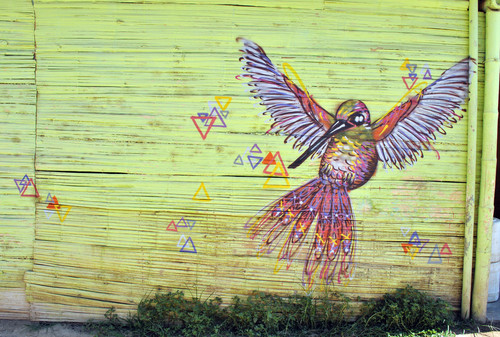
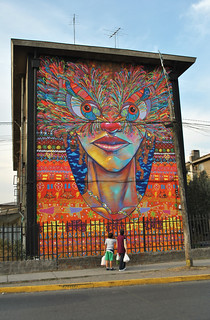
In Papo & Yo, players will notice images of birds, lions and portraits that appear sprayed, drawn, or painted on walls through all five acts. It’s worth noting that these are real works of graffiti art licenced for use in the game, taken from the vibrant street art scene in major cities like Brazil’s Sao Paulo, and Chile’s Valparaiso and Santiago. These cities are so renowned for their graffiti that, while Sao Paulo is a capital of the hip hop graffiti scene, it’s also grown to be one of the top traditional art capitals of the world.
Chile, too, is an international hub for artists and graffiti tourists in search of large canvases and inspiration. The most popular draw is Valparaiso, a bustling San Francisco-like port city where the neighborhoods look like stacked building blocks (like in Papo & Yo), built along hills. There’s an abundance of available surfaces to be blasted with color. Given that it’s a generations-old tradition, there’s a high standard to meet when emulating these works inside the game.
Sebastian Navarro (AKA Charquipunk), Simon Paulo Arancibia Gutierrez (AKA La Robot de Madera) and Inti Castro (AKA INTI) are the three celebrity graffiti artists lending their work to Papo & Yo. Charquipunk is known for his intricately detailed large-scale designs of cats and birds, while La Robot de Madera focuses on elaborate portraits. INTI is known for his work with kusillo, the Altiplano carnival clown whose costumes consist of clothing scraps. When they collaborate, which is often, each artist’s style is still distinct, but their synergy is electric.
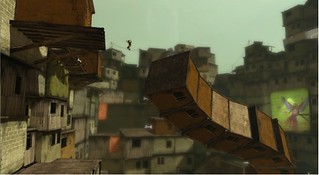
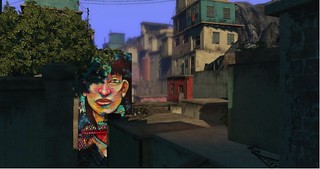
Their connection to Papo & Yo game developer, Minority Media, is through Montreal-based Pablo Aravena, a Chilean-born graffiti expert and filmmaker with several documentaries under his belt. These include Next: A Primer on Urban Painting and his upcoming Chile Estyle, which tells the fascinating story of Chilean graffiti evolving from Mexican muralist movements and mural brigades to the hip hop scene today. A longtime friend of Papo & Yo Executive Producer Ernest Webb, Aravena acted as art curator and consultant when it came to the graffiti that appears in the game. Aravena took care to ensure Papo & Yo’s environment is strongly reminiscent of Valparaiso, where subcultures collide into a dynamic tapestry of music, art, food, and personalities — like our three artists, whom he chose specifically. “The graffiti is a natural adaptation of the vibe in the city because it was always known as a bohemian town where dudes play boleros, the sailors get off the ships to party, and there are a lot of different communities,” says Aravena.
With Papo & Yo, the Minority team has tried to create an immersive experience in which players can “get lost.” The game has been categorized as fantastical realism, and there’s a sort of vulnerability that players will take on, simply by “being” in a new place. With the combination of authentically-inspired landscapes and a personally emotional story, that openness to new things is the driving force behind Papo & Yo.

On August 7th, PlayStation Plus members will get Telltale Games’ The Walking Dead Episodes 1& 2 added to their Instant Game Collection. That’s not all – in the next few weeks PlayStation Plus members will also receive significant discounts on the latest and best PSN games a part of PSN PLAY event, beginning tomorrow, July 31st.
July 31st PlayStation Plus Update
The Expendables 2 Video game20% off for PlayStation Plus Members (PSN Price: $14.99, PS+ Price: $11.99)
The 2012 PSN PLAY event kicks off with a first week discount on one of the most intense co-op shooters on PSN. Grab a friend (or three) and join four of the Expendables (Barney, Gunner, Caesar and Yin Yang) in a mission to rescue akidnapped billionaire. Featuring vehicular combat, four-player co-op story and challenge modes, and a wealth stages set in exotic locales, The Expendables 2 Videogame is a fantastic experience for gamers that dig hardcore shoot em up action.
Also, don’t forget that starting this week PlayStation Plus members can pre-order SoundShapes from the PlayStation Store and get 20% off boththe PS3 and PS Vita versions of the game (of which come bundled together for one price) as well as an exclusive PS3 theme. Note: Pre-orders for SoundShapes will only take place on the PS3 store as the gift with purchase theme is only useable for PS3 systems. Vita only owners don’t worry as you can still snag the 20% Plus discount on the store the 1st week the releases.
August 7th PlayStation Plus Update

br>
The Walking Dead Episode 1: A New DayFree for PlayStation Plus Members (PSN Price: $4.99)
The first episode from Telltale Games’ universally-acclaimed series The Walking Dead by will be available to all PlayStation Plus members as part of the Instant Game Collection! Follow a set of unique characters as they fight for survival amongst the ever-growing “walker” population, and encounter threats from both undead and human enemies.

br>
The Walking Dead Episode 2: Starved for HelpFree for PlayStation Plus Members (PSN Price: $4.99)
We’re also delivering PlayStation Plus members the second episode in The Walking Dead series as part of the Instant Game Collection! Following the decisions you made in A New Day, you’ll be confronted with even more gut-wrenching scenarios and thrilling action sequences with your fellow survivors. Like Episode 1, Starved for Help was adored by critics for its riveting gameplay and dramatic storyline, where players need to make harrowing decisions on the fly.
20% off for PlayStation Plus Members (PSN Price: $14.99, PS+ Price: $11.99)
This week marks the release of the highly-anticipated PSN exclusive SoundShapes. Marrying brilliant side-scrolling 2D gameplay with unique musical compositions, you’ll be hooked by the incredible landscapes you’ll see and hear in SoundShapes. Available for both PS3 and PS Vita systems together for one special price, PlayStation Plus members will be getting the absolute best deal with a 20% discount. If you already had your pre-order locked in, you’re all set! Make sure to check out the trailer above, which introduces musicians Beck and Pyramid Attack into the lineup of amazing levels in SoundShapes.
With the August 7th update, you’ll also be able to pre-order the next PSN PLAY game Papo & Yo, which will also have a 20% discount for all PlayStation Plus members. Everyone that pre-orders the game will get an exclusive Papo & Yo theme, so don’t sleep on it!
We’ll be coming at you with another update on August 13th, with more additions to the Instant Game Collection and additional awesome sauce. Until then, watch the PS.Blog for our weekly PlayStation Store Updates to see what additional content is added for PlayStation Plus members. Please leave us your feedback in the comments, and help us by rating the Instant Game Collection lineup on a scale from 1 – 10. If there was one thing you could change about PlayStation Plus, what would it be?


We’re very happy to announce the return of PlayStation PLAY, our annual summer program showcasing a diverse lineup of great PSN games and special offers. PSN PLAY begins July 24 on PSN when the first game in the lineup becomes available for pre-order, and we have all the info on this summer’s offering.
You may remember my announcement last summer that PLAY would become an annual program. Guess what? It has returned and we do have a stellar line-up of titles for you this year. We’re again offering 20% off each title for PlayStation Plus members for a limited time, and as a bonus this year, we’re giving you cash vouchers to redeemed on PSN for purchasing any two or more of the awesome PSN PLAY titles. Check out what you could get after buying PSN PLAY games:

If you are a fan, you will also appreciate the fact that each of the four PSN PLAY titles in our line-up can be pre-ordered starting a week before they hit the PlayStation Store. Gamers who buy a PSN PLAY game during its pre-order period will receive a PS3 XMB theme of the game. PlayStation®Plus members also get 20% off each title during their pre-order period.
The best thing about PSN PLAY 2012 is still its line-up of great games. They all have something special to offer to PSN gamers.
- PLAY The Expendables 2 Videogame (PS3) First On PSN before anyone else!
- PLAY Sound Shapes (PS3/PS Vita) Anywhere as we offer the PS3 and PS Vita version of the game for the price of one.
- PLAY the indie phenomena Papo & Yo (PS3) Exclusively On PSN
- PLAY Counter Strike: Global Offensive (PS3) Hardcore Action with your DualShock or PlayStation®Move controller.
Check out all details about the four PSN PLAY games:

July 31: The Expendables 2 Videogame (PS3) – Leading off the PLAY promotion and launching first exclusively on PSN, the latest and most explosive co-op action shoot’em up title coming to PSN, based on the popular movie franchise this game leads players right into the upcoming The Expendables 2 movie. The story begins when four Expendables (Barney, Gunner, Caesar and Yin Yang) are hired to rescue an extremely valuable, kidnapped Chinese billionaire. Featuring vehicular combat, four-player co-op story and challenge modes, and a wealth of exotic locales, The Expendables 2 Videogame offers everything an action-game fan could want. Pre-order The Expendables 2 Videogame starting July 24 for $14.99 ($11.99 for PLUS members) and check out the following trailer.

August 7: Sound Shapes (PS3/PS Vita) – Play, Compose and Share in a unique take on the classic sidescrolling platformer where your actions make the music. Equal parts instrument and game, Sound Shapes gives everyone the ability to make music. Play through a unique campaign that fuses music and artwork into a classic 2D platformer featuring artwork by Pixeljam, Capy, Superbrothers and more, with music by I Am Robot and Proud, Jim Guthrie and Deadmau5. Additionally, Sound Shapes comes to the PLAY program as a cross-platform title, allowing players to play at home on their PS3, or take it on the go with PlayStation Vita. Create and upload your levels on either platform for others to download and remix on their own. Sound Shapes creates an ever-changing musical community for everyone to enjoy, anywhere. Pre-order Sound Shapes starting July 31 for $14.99 ($11.99 for PLUS members).

August 14: Papo & Yo (PS3) – PSN exclusive indie game Papo & Yo tells the story of a young boy, Quico, and his best friend, Monster. Taking place in a dreamlike world inspired by South American favelas, Papo & Yo entices players to explore and solve puzzles as Quico, while simultaneously preventing Monster from eating poisonous frogs, which throws him into an uncontrollable rage. As one of PSN’s most-anticipated indie titles, Papo & Yo is a truly unique and beautiful experience that players can only get on PSN. Pre-order Papo & Yo starting August 7 for $14.99 ($11.99 for PLUS members).

August 21: Counter-Strike: Global Offensive (PS3) – One of the gaming world’s most celebrated first-person shooter series makes its way to PSN with Counter-Strike: Global Offensive, offering an updated take on the tried-and-true objective-based gameplay. Pitting teams of counter-terrorists against terrorists, Global Offensive features a number of classic game types like Bomb Diffusal and Hostage Rescue, and introduces two new modes: Arms Race and Demolition. Up to 10 players can engage in online matches, and the game also supports PlayStation Move, giving players a brand new way to experience the classic Counter-Strike gameplay. Pre-order Counter-Strike: Global Offensive starting August 14 for $14.99 ($11.99 for PLUS members).
Don’t forget to take advantage of each game’s limited-time 20% discount if you are a PlayStation Plus member, and keep your eyes on the PlayStation Blog for full blog posts on each of the PSN PLAY titles soon! For more information about PSN PLAY and the rest of the lineup of games available on PlayStation Network, please visit www.us.playstation.com/PSNplay.



Hello everyone! As some of you may already know, the wonderful team at PlayStation is giving us an opportunity to show off a brand new demo for Papo & Yo at their booth next week during E3. We’re thrilled to have another opportunity today to give you an early peek at some of what attendees will be playing during the show, as well as a few parts of the game that have never been seen before. With that, I’d like to present the latest Papo & Yo trailer, which we’re calling “the Changing World!”
We hope you like it, and keep an eye out for some great stories about Papo & Yo from Los Angeles over the next week!

Hello again! Last time I was here I talked about the redesign of Monster – now I want to give everyone an even closer look at the creative and design process for Papo & Yo in our first-ever dev diary. Please take a look – you’ll get a glimpse of Minority’s office, some new ways you can interact with Monster, and even see the first prototype I designed for the game!
If you’ve been following Papo & Yo‘s development, you know that the game was inspired by my childhood in South America and my relationship with my father. But I don’t want that to be the only thing that people see when they get to play the game. Papo & Yo is also about a child’s imagination, and experiencing “fantastic realities” – transforming the real world into a special world that can both help and challenge you. I feel such joy when I play with my boy and see him imagining his toys coming to life – I hope that everyone will feel this when they play Papo & Yo.
Thank you – and stay tuned! We are working on another dev diary that will give you insight into what went into creating Papo & Yo’s music (hint: it involves a great composer and a big trip to South America). Also, be sure to look out for us at E3 again this year!



Hello everybody! We’ve been hard at work since we first unveiled Papo & Yo last summer, and the game has come a long way in the past few months. As we get ready to (finally!) show off more of the game next week at the Game Developers Conference in San Francisco, I wanted to take the opportunity to tell you all a little bit about how Monster – a character very important to both the story and to me personally – has evolved since my initial concept into the Monster you see today.

If you’ve been following Papo & Yo, you may remember that Monster represents my father, a man I had a difficult relationship with. To tell the story I wanted to tell – my story – I knew that this character had to show the positive aspects of the man I loved… and the negative aspects of the man I feared. This turned out to be challenging – I knew who Monster was, but not what he looked like. Luckily, I’m extremely fortunate to have friends like Nilo Rodis, a man who has worked on the art for movies ranging from Pixar titles to Star Wars, and the man who helped me find my father in Monster.
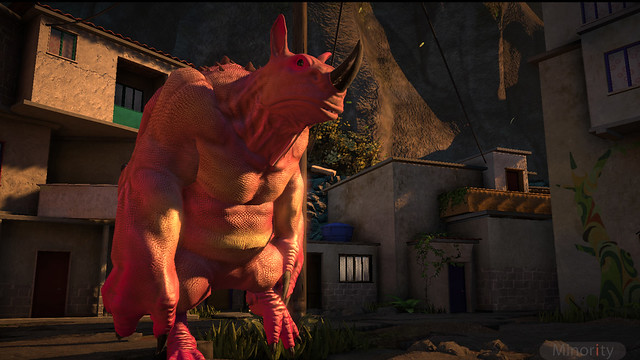
Nilo and I met during my time at EA, and when I started Minority as a way to make more personal games, he was one of the first people I started talking to. After I came to Nilo with the concept of Papo & Yo, we didn’t talk for a while – I basically buried myself in developing the game. When I finally had a prototype ready, Nilo liked it but saw problems with the way Monster looked – too much like a puppy, he thought. He asked me, “Do you see your father in that character?” and I honestly couldn’t say I did.
Nilo agreed to help us redesign our characters, and our final Monster, which you can see below, is big and powerful. He’s scary, but there is something that attracts you to him – something that makes you want to play with him, help him, even though he’s a beast who could fly into a rage and kill you.
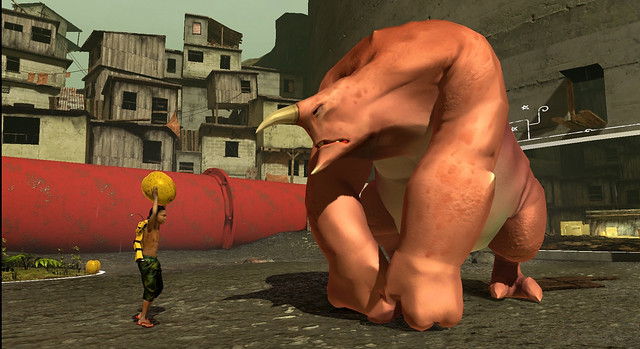
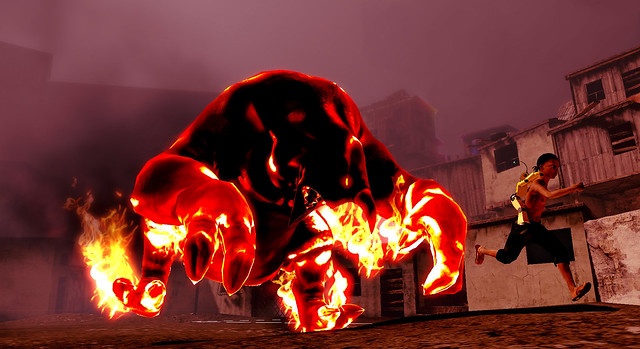
Can’t wait to show you more of Monster and the game in the coming months!

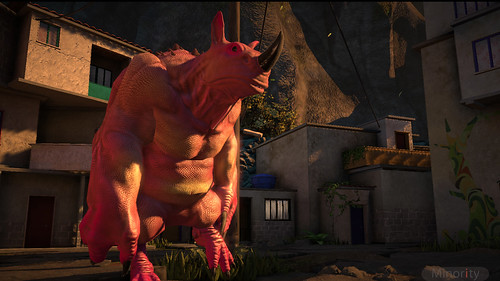
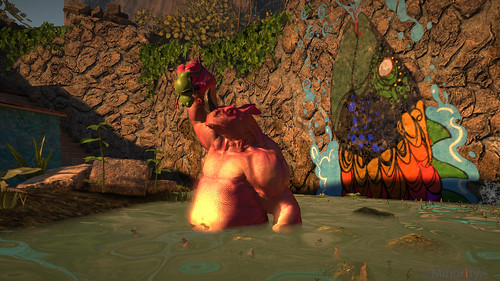
Puzzle-platformers are no rare breed on PSN, but one upcoming title, Papo & Yo, is looking to revitalize the genre in a number of intriguing ways. Introduced in early June on the PlayStation.Blog, Papo & Yo tells the story of Quico, a young boy who has an unlikely best friend: a giant hulking beast named, appropriately, Monster. Together, the duo must navigate an ethereal world that’s reminiscent of a South American town but is set entirely in Quico’s imagination. The world itself is made up of dream-like neighborhoods to roam and populated with puzzles to solve.
After getting my hands on the game at E3, it didn’t take long to notice the unique approach developer Minority is taking when it comes to navigation and puzzle solving. Controlling Quico from a third-person perspective, I wandered a bit around Papo & Yo’s surreal world. Players can easily run and jump around the expansive environments, and also use visual cues to direct Monster (as well as a cute little flying robot named Lula) to points of interest. Utilizing all three characters to solve puzzles is key to progressing in the game, and once you learn a few basics—Monster is good at moving heavy objects, for example, and Lula can reach high areas inaccessible to Quico—the gameplay becomes surprisingly intuitive.
What really impressed me while playing is how the world changes according to Quico’s actions. Picking up a series of unassuming boxes near a line of houses causes the actual individual houses to lift off the ground and move according to where Quico places the boxes. Placing the boxes inside a nearby chalk outline causes the houses to create a rooftop bridge for Quico to cross. The entire segment really helped highlight the dream-like nature of Papo & Yo’s world.
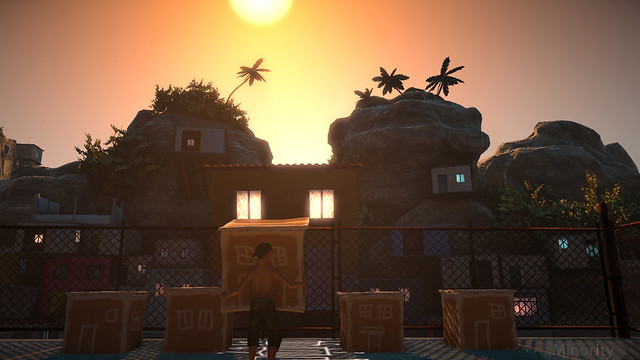
There is, however, a dark side to Papo & Yo. If Monster happens to come across a poisonous frog (his favorite snack) and eat it, he’ll be thrown into a frenzied rage that puts Quico’s life in danger. Papo & Yo creative director Vander Caballero explained that Monster’s addiction to poisonous frogs is meant as an analogy to his own father’s substance abuse, which greatly affected the developer when he was a young boy (like Quico). Preventing Monster from eating the frogs, or hightailing Quico away from him if he does, is key to survival throughout the game.
There’s still plenty more of Papo & Yo that I can’t wait to see, but the game is already looking and playing wonderfully. Keep your eyes on the PlayStation.Blog for more news down the line.

When I first met Vander Caballero, I was immediately struck by his infectiously positive attitude. By the time I caught up with him midway through day two of E3 2011, most people trudging around the West Hall of the LA Convention Center stood slump-shouldered and somber-faced, exhausted by the grind of the show. Caballero had no such air about him.
Papo & Yo creator Vander Caballero.He bounded up to the kiosk in the Sony booth where I was waiting for him, and did so with a kind of energy I didn't think could exist by this point at E3. As we began talking, I could sense a bit of weariness in his voice, which certainly made sense given the rigors of E3. But the smile hardly left his face during the entire course of our conversation. This was a man who seemed truly excited to be where he was at that very moment.
He had good reason for such enthusiasm, as Papo & Yo, his newly-announced PlayStation Network project, was making its playable debut. The game is the first project from Minority Media, the independent studio that Caballero helped found in Montreal, Quebec. For any independent developer, it can be an exciting experience to finally show to the world the thing you've poured months, or even years of time and effort into. But in the case of Caballero, it's not just his time and effort he's dedicated to this project, as the story of Papo & Yo is meant to be a metaphor for his own troubled childhood.
The game features a young South American boy named Quico, along with his two friends, a small robot named Lula, and a pink rhinoceros-looking creature known as "Monster," who has an unhealthy addiction to eating frogs. Quico's relationship with Monster is meant to echo that of Caballero and his father, who throughout his life suffered from alcohol and drug dependency. Like the Monster in the game, Caballero father had two sides: a loving, friendly side, and a monstrous, evil one. In effect, Caballero is pouring the very essence of his life's experience into this game, while trying to turn a very tough story into something fun and engaging for a wide variety of players. No easy feat, to be sure.
What I've played of the resulting game is a fascinating combination of wordless storytelling and third-person, puzzle-based platforming. Quico moves through an imaginary world that feels loosely based in reality. You see mountains, favelas, and other elements of South American landscapes you'd expect, but that world can be manipulated. Chalk drawings on various structures can be played with to reveal new paths, or allow Quico to literally transport buildings and other obstacles that would normally seem immovable. What I played of the game at E3 seemed extremely promising, despite the game's relatively early state of development (the game won't release on PSN until next year).
In talking to Caballero, I found myself less interested in the usual mechanic-and-multiplayer-focused questions one tends to ask during these sorts of events, and more interested in the inspirations behind Papo & Yo's creation. I wanted to know what would inspire a developer who had spent years working on successful franchises at EA Montreal to start his own company and create such an unusually personal video game experience. Thankfully, Caballero was more than happy to oblige, talking with the kind of openness that you really only tend to find in someone who is truly independent, and truly doing exactly what they want to be doing.
Giant Bomb: You don't often hear game designers specifically reference or talk about personal experiences when describing inspiration for their games, let alone personal trauma. What led you to the point where you decided that you wanted to make a game about something so specifically personal?
Vander Caballero: It was my love for games, I think. When I was a kid and going through difficult times, games actually saved me. It was the only space where I could be in control and... experience safety, and predictability in a way. Everything outside was crazy.
I was a director for Army of Two, I worked on Need for Speed, I worked on FIFA, all these major EA franchises. I learned how to make really high quality games with them, but this was my opportunity to jump out and tell my story. We all want to tell our stories. The difficult part is finding the right metaphor. I had a mentor, Nilo Rodis, who worked on Star Wars, and has worked with Pixar. He taught me a lot about how you have to find the right metaphor to tell your story and not freak people out. And I think that the magic part that we have to learn in this industry, is how we have to find these metaphors that are meaningful to bring the real human story out there. It's really hard, but I've learned, and I hope I can do this many times!
GB: Is the specific story of Papo & Yo a metaphor you've always had in the back of your head? Or did it only come to you recently?
VC: First, you have to work on yourself and understand your emotions inside. They say you cannot bring someone where you have not been, so first you have to go there, come back a better man, and then you can bring people with you. Once you've done that, then you can say, "Okay, what's the metaphor I'm going to use, and then how am I going to make this truthful to games?" Because, it's about telling your story through a simulation, and you have to use simulation rules to tell the story. And that can be really hard. It requires a lot of know-how, it requires a lot of systems, it requires a lot of experience and failure to get there, so it took me a long time to figure that out.
I don't want to make a game where you just say, "Oh, I'll put a cinematic there," because it doesn't work that way. I want people to feel it and finally when you get there, and you see the Monster angry... we're not actually showing it here, but we have it at the office, we've been testing it with people, and when the Monster becomes angry, you see right away that people change, the complete feel of the game changes, and you are performing in a different way. It's a beautiful way to see it.
One thing... in order to take away the Monster's anger, you can give him a fruit. Every time people were taking the fruit and giving it to the Monster and he became normal again, I was like, *sigh of relief*. It moved everyone, even myself. When you have a person who is addicted, you always want to save them. You always want to try to save them. But you actually can't.
GB: Was that your experience? Did you spend a lot of time growing up trying to save your father?
VC: Oh yeah, all the time. You always try to find a way, but you can't. You're just a kid.
GB: One of the things I noticed when playing the game was that there aren't really any other human characters around, it seems. You had said before that you had felt very alone in your situation growing up. Is Quico's world specifically representative of that feeling?
VC: Right now what you're seeing is the imaginary world that Quico created to protect himself from the outside, and once in a while there's a kid who appears here and there and does drawings to transform the world [referring to the sketch drawings related to the game's puzzles]. And that is what the game is, it's about how you transform the world around you and make it magical. But in your game in the story, you're going to get some flashbacks. You're going to go back to another time... and then you're going to go back again... that's all I'm going to say, I won't tell you more about that yet.
GB: Creating a game around a subject like addiction, even in whimsical, metaphorical fashion, can be a dicey subject, given how dark the subject matter is. Was crafting the right tone for the game a difficult challenge for you?
VC: I got the chance to work with Nilo, and he gave me a lot of advice on how to do that. Pixar does that in amazing ways. If you remember Finding Nemo? What a terrible story! Five minutes into the story, you lose your mom, you lose your brothers. Ten minutes into the story, you're lost. But they are able to bring these really heavy stories and immerse you in them, without making you feel afraid. That's what I want to do.
GB: Do you feel like you have achieved that balance? That this is the sort of game that accurately captures your story, while still being a fun, accessible experience that anyone could to pick up and play?
VC: Oh yes. The only thing I could say that perhaps is a flaw in the game is that it's in third-person. And third-person limits the amount of people who are going to play it. I would love for more people to play it, but I love third-person games! So that's the only thing maybe is that it might be hard for people who don't know how to play third-person games.
GB: Has creating Papo & Yo been a therapeutic experience for you?
VC: It's great, and scary at the same time. Because after I do this game I don't know what I'm going to do! So I have to get through this one and I don't know... but it's been really great, and really liberating. The best thing of all is seeing people who actually enjoy and appreciate the story, because it's an honest story. You know, like, I cannot see another shooter. They're so detached, there's no emotion, there's no personal story, there's no growth.
GB: Do you have children of your own?
VC: Yes, I have a child. He's two years old.
GB: I ask because I recently came across the story of another Canadian developer named Ryan Creighton who actually involved his child in the making of a game that she helped design. It was a flash-based game called Sissy's Magical Ponycorn Adventure, and she drew all the art and did all the voice acting for it. Creighton wrote a blog about how much she loved working on it with him. Did you hear about any this?
VC: I had not heard about this! You know, when I did the first prototype, I asked my nieces (my child is still to young), to draw the icons and everything I put it in the game. That's something in the game that's going to happen later on. We didn't have time to input that exact childish... view into the world, but we had it in the prototype and it was really successful.
GB: One of Creighton's quotes about the experience of making that project with his daughter was that "Our goal as parents is to give our kids the kind of childhood we would kill to have had." Do you feel like this game is an extension of that notion? In creating this game, do you feel like you're making something to help your own children understand how you grew up, and how to face such a challenging situation?
VC: I think it's right. We always want to give our children the childhood we didn't have. But, it's also crucial to pass your learning on to your children. So when I was a kid I was playing Nintendo, it was more about things being "good" or "bad." You're Mario, and the rest are evil. Life is not like that. What I want to do in the game, your Monster is your friend, you're going to love him, but he can also turn bad. He can be evil. That's what I want. I want a kid playing this game to get a little more out of it, to gain more satisfaction and growth than they otherwise would. That's my goal.
GB: In your PlayStation blog announcement, you actually mentioned Shigeru Miyamoto as a big influence on you as a designer. Is there anyone else in the game industry you can cite as a particular person of influence on your sensibilities as a designer?
VC: Fumito Ueda. ICO was a great inspiration for me. They told a beautiful story, a deep story, and they did it with mechanics. I learned a lot from that, how I can tell my story with mechanics.
GB: What is the one thing for anyone playing Papo & Yo that you most want them to take away from the experience?
VC: *grins* That you can get a beautiful experience that is not a shooter.


Amid the din of sequels, shooters, sports games, and whatever other savorless noise we tend to find ourselves inundated with come E3 time, it's a pleasant rarity when a smaller project finds a way to stand out in the crowd and make an immediate impression.
One such project is the newly announced Papo & Yo for PlayStation Network, a game from indie studio Minority Media and the mind of its Creative Director, former EA Montreal CD Vander Caballero. Making its debut on the PlayStation Blog, this inventive-looking title stars a young boy growing up surrounded by South American favelas. He has a best friend, aptly named Monster, who acts as his protector, but also has a dark side. Monster is addicted to eating frogs, and when he eats them, he becomes a destructive terror, even to the boy himself. His only mission is to cure Monster of the disease that afflicts him.
Addiction is not something that's been addressed in games much outside of the basest examples--see any iteration of NARC, or Grand Theft Auto--but for Caballero, it's a very personal thing. The relationship between the boy and Monster is meant to directly mirror that of Caballero and his father, who was himself an abusive addict. There's no sense in me recapping the entire blog entry, since his words will ring much truer than anything I would repeat. You should read it for yourself.
While the subject matter is dark, Caballero and team seem to have found a fascinating balance between addressing the personal issues at play, and creating a fun game that people would actually want to play. You can see more for yourself in the trailer, which I've embedded at the bottom of this story.
Thankfully, Papo & Yo will make its playable debut at E3, and now all that's left is for Patrick and myself to have a knife fight to determine who gets to go check it out.
















